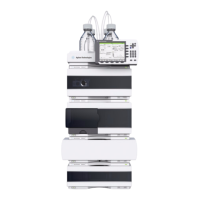Purification Solution - Developer's Guide 65
Calibration Procedures
6
Characterizing the column volume
• Enter the Vial/Location of the sample vial
• Enter a run name.
• Run the method.
10 Stop the run after the delay marker peak has been detected.
11 Repeat twice.
12 Install the target column.
13 Equilibrate the column until the pressure and UV signal are stable.
14 Set a suitable flow in the range 0.2 – 4 mL/min in a way that the marker
elutes at 1 min or later. Since the expected column volume is around one
half of a geometric column volume (cross-sectional area multiplied by
length), set the flow to around one half of a geometric column volume in mL
(for example, the geometric volume of a 4.6 × 50 mm column is 3.14 × 4.6 ×
4.6 × 50 ÷ 4000 = 0.83 mL, which suggests a flow rate of 1/2 × 0.83 mL / 1
min = 0.4 mL/min).
15 Adapt the injection volume to the applied flow (and column volume):
• Flow 0.2 – 0.5 mL/min: inject 1 μL.
• Flow 0.5 – 1.0 mL/min: inject 2 μL.
• Flow 1 – 2mL/min: inject 5μL.
• Flow > 2 mL/min inject 10 μL.
16 Note the applied flow rate and injection volume.
17 Open the Sample Info window, update the run name and run the method.
18 Stop the run after the delay marker peak has been detected.
19 Repeat twice; it is sufficient to measure runs longer than 5 min once or
twice.
20 Evaluate the data:
a Read the elution time of all peaks at the apex.
b The elution volume without the column:
• Calculate the average elution time of data without the column.
• Multiply it by the applied flow rate.
• Subtract the volume of the restriction capillary if used and one half of
the injection volume.
c The final column volume:
• Calculate the average elution time with the column.

